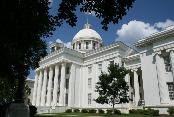secession etiketine sahip kayıtlar gösteriliyor. Tüm kayıtları göster
secession etiketine sahip kayıtlar gösteriliyor. Tüm kayıtları göster
2 Eylül 2011 Cuma
12 Ocak 2011 Çarşamba
Alabama State Capitol & the Secession of Alabama - Montgomery, Alabama
 |
| Alabama State Capitol |
The secession vote took place on January 11, 1861, as Alabama became the fourth state to leave the Union. South Carolina, Mississippi and Florida had already done so. The Alabama secession document holds a unique place in Southern history, however, as it also included an invitation for other Southern states to convene in Montgomery on February 4, 1861, to consider measures for the "common peace and security." This invitation, of course, led to the formation of the Confederate States of America and the designation of Montgomery as the first capital of the new nation.
The Alabama Ordinance of Secession was also unique in that it specifically named the election of Abraham Lincoln as President and Hannibal Hamlin as Vice President as the primary reasons for the state's departure from the Union.
 |
| Where Jefferson Davis took the Oath of Office |
Jefferson Davis took the oath of office as President of the Confederacy on the front portico of the building (a bronze star marks the spot) and it was hear that decisions were made leading to the firing on Fort Sumter in April of 1861 that officially ignited the Civil War (or War Between the States).
The Alabama State Capitol later played a pivotal role in the Civil Rights movement and remains in use today as the center of government in the state. It is listed on the National Register of Historic Places. To learn more, please visit www.exploresouthernhistory.com/montgomerycapitol2.
If you are interested in learning more about the events of the War Between the States as they happened, please follow this link to check in daily with our new online journal: Civil War Daily!



